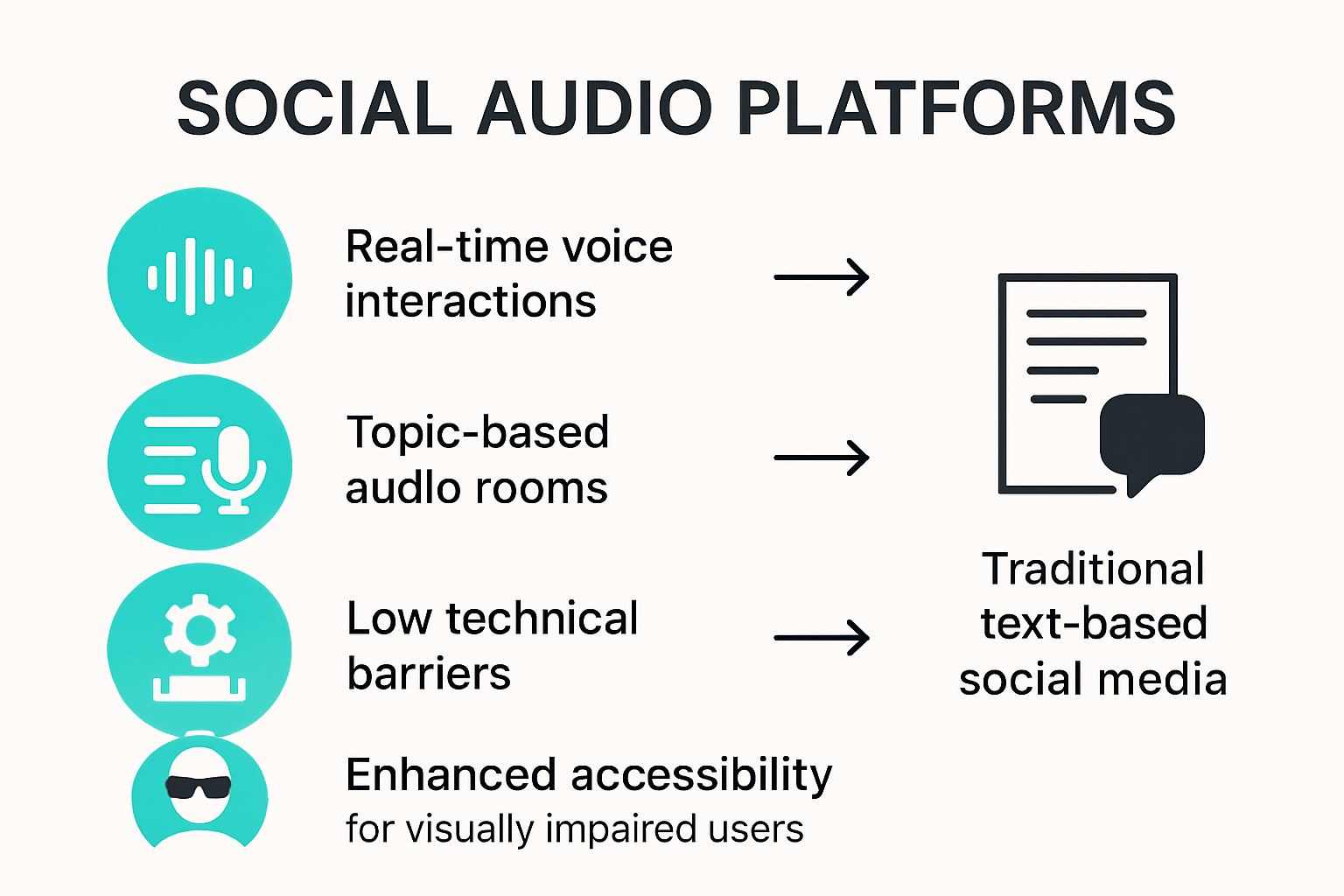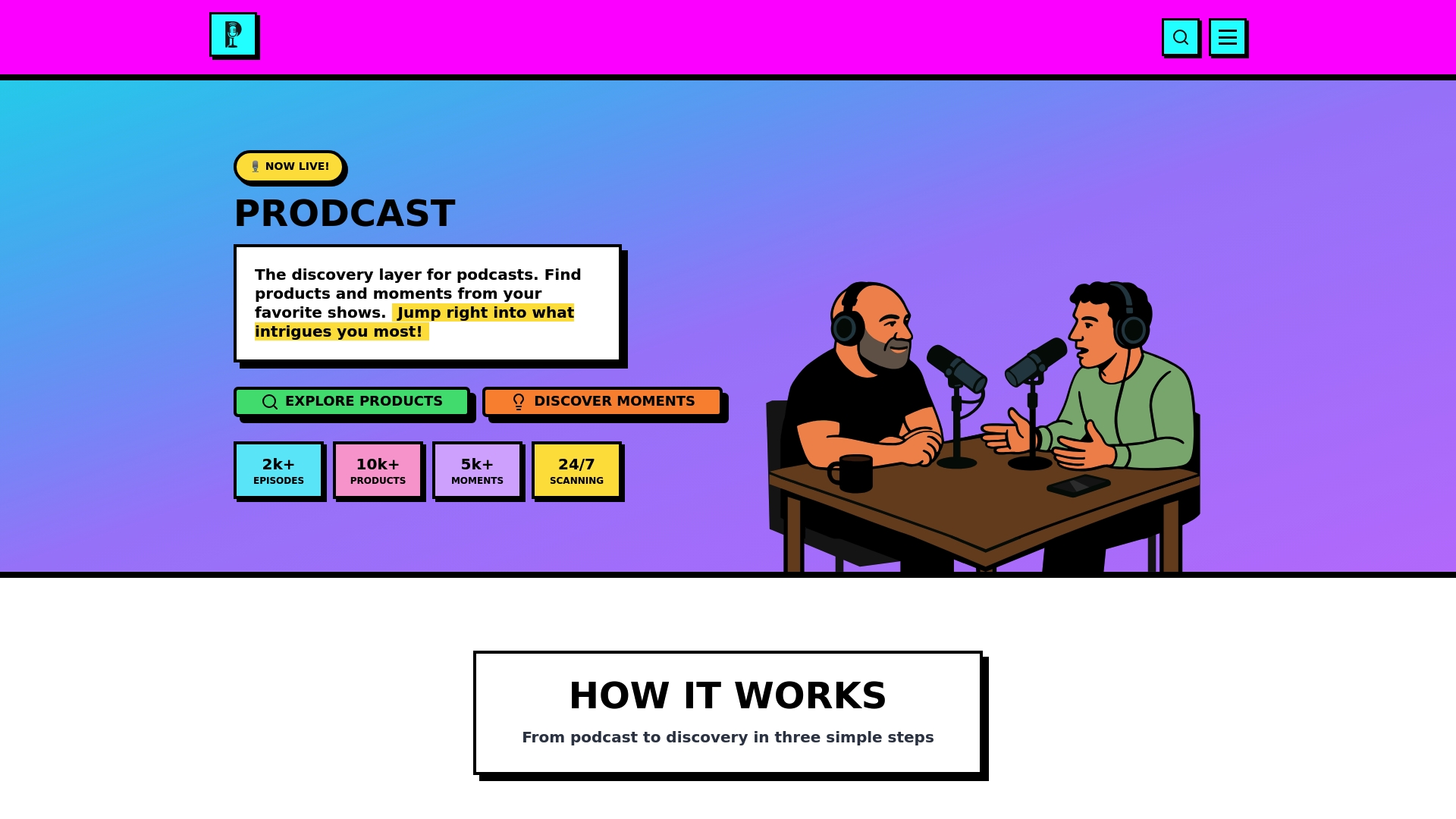CATEGORIES
TAGS
Understanding Social Audio Platforms: A Deep Dive
Social audio platforms are shaking up how people connect online and making headlines for their unique twist on digital conversations. Most people think communication needs text or video, but these tools are changing the rules. In fact, research shows that vocal inflection and tone can deliver much more emotional depth than written words ever could. So what happens when the human voice takes center stage and replaces the usual typing and scrolling? You might be surprised at how much more real and meaningful those digital interactions feel.

Table of Contents
The Importance Of Social Audio Platforms In Modern Communication
How Social Audio Platforms Function: Key Features And Technologies
Quick Summary
TakeawayExplanationSocial audio platforms prioritize voice communicationThese platforms focus on real-time voice conversations, enhancing authentic interactions among users.Reduce visual pressure in communicationUsers can engage without worrying about their appearance, fostering more spontaneous and genuine conversations.Accessibility for diverse usersSocial audio platforms cater to visually impaired individuals, offering alternative ways for communication and connection.Utilize advanced technology for seamless interactionThey leverage sophisticated audio streaming and networking technologies, ensuring high-quality voice experiences.Future innovations will enhance user experiencesAnticipated advancements include AI-powered translation and contextual audio recommendations for personalized interaction.
What Are Social Audio Platforms and Their Purpose?
Social audio platforms represent an innovative digital communication ecosystem where users connect, interact, and share content exclusively through audio experiences. These platforms transform traditional social media interactions by replacing text and visual posts with real time voice conversations, live audio rooms, podcasts, and interactive voice channels.
The Emergence of Voice-Based Social Networks
Unlike traditional social media platforms that rely on text, images, and video, social audio platforms prioritize human voice as the primary medium of communication. These digital spaces enable users to engage in spontaneous, authentic conversations without the pressure of visual presentation. Emerging audio technologies have made these platforms increasingly accessible, allowing people worldwide to connect through voice.
Key Characteristics of Social Audio Platforms
Social audio platforms share several distinctive features that set them apart from conventional social networks:
Real-time Voice Interactions: Enabling live, unscripted conversations between users
Topic-Based Audio Rooms: Allowing users to join discussions on specific interests
Low Barrier to Entry: Requiring minimal technical skills to participate
Enhanced Accessibility: Providing communication options for individuals with visual limitations
These platforms fundamentally reimagine social connectivity by creating intimate, human-centered digital spaces where conversation feels more natural and spontaneous. By leveraging voice technology, they break down visual barriers and create more genuine human connections in the digital realm.

The Importance of Social Audio Platforms in Modern Communication
Social audio platforms have emerged as a transformative communication technology, bridging human connections in ways traditional digital platforms cannot. By prioritizing authentic voice interactions, these platforms address critical communication challenges in an increasingly digital and fragmented world.
Rebuilding Authentic Digital Connections
In an era dominated by text-based and visual social media, social audio platforms reintroduce the nuanced emotional depth of human voice. Communication research reveals that vocal tone, inflection, and spontaneity carry significantly more emotional information than written text, enabling more genuine and empathetic interactions.
Breaking Down Communication Barriers
Social audio platforms offer unique advantages for diverse communication needs:
Accessibility for Diverse Users: Providing communication channels for visually impaired individuals
Global Language Exchange: Enabling real-time language learning and cultural understanding
Professional Networking: Creating intimate professional dialogue spaces beyond traditional text-based platforms
Psychological and Social Impact
Beyond technological innovation, these platforms address fundamental human needs for connection. By reducing the visual performance anxiety associated with video communication, social audio platforms create more inclusive spaces where individuals can express themselves authentically. The human voice becomes a powerful tool for building trust, understanding, and meaningful relationships in digital environments that often feel impersonal and disconnected.
How Social Audio Platforms Function: Key Features and Technologies
Social audio platforms leverage sophisticated technological infrastructures that enable seamless, real-time voice communication across global networks. These platforms combine advanced audio streaming technologies, robust networking protocols, and intelligent user experience design to create immersive digital conversation spaces.
The following table breaks down the key technological components and features that enable seamless voice communication on social audio platforms.
Technological ComponentDescriptionReal-time Audio CodecsHigh-quality voice transmission using minimal bandwidthAdaptive Bitrate StreamingAdjusts audio quality based on network conditionsNoise Reduction AlgorithmsMinimizes background noise for clearer audioWebRTC TechnologiesEnables low-latency, peer-to-peer voice communicationDynamic Room ManagementAllows smooth entry/exit and moderation of audio spacesPrivacy/Security ProtocolsEnd-to-end encryption and user consent mechanismsAlgorithmic User MatchingConnects users by shared interests for relevant conversations
Technical Architecture of Voice Transmission
At the core of social audio platforms are complex signal processing technologies that compress, transmit, and reconstruct human voice with minimal latency. Advanced audio engineering research demonstrates how these platforms utilize adaptive bitrate streaming, noise reduction algorithms, and WebRTC technologies to ensure crystal-clear audio quality across diverse network conditions.
Key Technological Components
Social audio platforms integrate multiple sophisticated technological elements:
Real-time Audio Codecs: Enabling high-quality voice transmission with minimal bandwidth consumption
Dynamic Room Management: Facilitating seamless entry, exit, and moderation of audio conversation spaces
Privacy and Security Protocols: Implementing end-to-end encryption and user consent mechanisms
User Experience and Interaction Design
Beyond raw technological capabilities, these platforms excel in creating intuitive, engaging user experiences. Intelligent algorithmic matching connects users with shared interests, while sophisticated permission systems allow granular control over conversation participation. The result is a dynamic, responsive communication environment that feels both technologically advanced and deeply human.
Understanding User Engagement on Social Audio Platforms
User engagement represents the cornerstone of social audio platforms, transforming passive listening into active, dynamic social experiences. These platforms have developed sophisticated mechanisms to create compelling, interactive environments that draw users into meaningful conversations and community interactions.
Psychological Drivers of Audio Interaction
User experience research reveals that social audio platforms tap into fundamental human communication needs. Unlike text-based platforms, voice interactions provide nuanced emotional context, allowing users to form deeper, more authentic connections. The spontaneity and immediacy of audio communication reduce the performative aspects of traditional social media, encouraging more genuine exchanges.
Engagement Mechanisms and Participation Strategies
Social audio platforms employ multiple strategies to enhance user involvement:
Interest-Based Room Curation: Enabling users to discover and join conversations aligned with their specific passions
Interactive Participation Models: Allowing listeners to raise hands, ask questions, and dynamically contribute to discussions
Social Recognition Systems: Implementing reputation and contribution tracking to motivate meaningful participation
Community Dynamics and Social Learning
User engagement transcends mere conversation, evolving into a powerful social learning ecosystem. These platforms create spaces where knowledge sharing, cultural exchange, and professional networking happen organically. By removing visual barriers and emphasizing vocal communication, social audio platforms democratize information exchange, allowing diverse voices to connect, collaborate, and learn from one another in real-time digital environments.

Exploring the Future Trends of Social Audio Platforms
Social audio platforms stand at the forefront of a digital communication revolution, poised to transform how humans connect, share information, and build communities in an increasingly interconnected world. The trajectory of these platforms suggests a future where voice becomes the primary medium of digital social interaction.
Technological Convergence and Innovation
Emerging technology research indicates that social audio platforms will increasingly integrate advanced artificial intelligence and machine learning technologies. These innovations will enable more personalized, intelligent audio experiences that can dynamically adapt to user preferences, context, and communication styles.
Anticipated Technological Developments
The future of social audio platforms will likely include groundbreaking technological advancements:
AI-Powered Voice Translation: Real-time language translation during conversations
Contextual Audio Recommendations: Intelligent matching of users based on interests and communication patterns
Enhanced Privacy and Consent Mechanisms: Sophisticated controls for user data and interaction preferences
Societal and Cultural Impact
Social audio platforms are evolving beyond mere communication tools, emerging as powerful spaces for global cultural exchange, education, and community building. By removing geographical and visual barriers, these platforms democratize access to knowledge, enable cross-cultural dialogues, and create unprecedented opportunities for human connection. The future of digital communication is not just about technology, but about creating more empathetic, inclusive, and interconnected global conversations.
Take the Next Step: Turn Social Audio Insights Into Seamless Commerce
Social audio platforms are reshaping how we connect, making digital communication feel more authentic and spontaneous. Yet, too often these powerful conversations become just fleeting moments. Listeners miss out on discovering products mentioned in real time. Entrepreneurs struggle to turn genuine engagement into real opportunities. If you want to unlock the true potential of social audio interactions, you need a smarter way to bridge conversation and commerce.

Put your knowledge into action with Prodcast. Experience AI-powered podcast scanning that surfaces product mentions as they happen so you or your audience can instantly discover and purchase through our dynamic marketplace. Take control as a vendor, bid on the keywords that matter most, and turn every mention into a business opportunity. Transform passive listening into real engagement and start making every voice count. Visit https://prodcastapp.com today to explore and act on every important moment.
Frequently Asked Questions
What are social audio platforms?
Social audio platforms are digital environments where users engage and communicate through voice interactions, such as live audio rooms, podcasts, and audio conversations, instead of traditional text or visual posts.
How do social audio platforms enhance communication?
Social audio platforms enhance communication by allowing for real-time voice interactions, which convey emotional nuances and create more authentic and spontaneous conversations, reducing visual performance anxiety typically associated with video communication.
What key features distinguish social audio platforms from traditional social media?
Key features of social audio platforms include real-time audio interactions, topic-based audio rooms, low barriers to entry for users, and enhanced accessibility for individuals with visual impairments, fostering a more inclusive communication environment.
To help clarify the unique aspects of social audio platforms compared to traditional social media, the table below summarizes the main features that distinguish them.
FeatureSocial Audio PlatformsTraditional Social MediaPrimary Mode of CommunicationVoice (Audio)Text, Images, VideoReal-Time InteractionYes (live conversations)Often delayed (comments/posts)Visual RequirementNot requiredOften required (photos/video)Accessibility for Visually ImpairedEnhancedLimitedPressure of AppearanceReducedPresentTopic-Based Audio RoomsYesRare/Not core featureParticipation BarrierLowVaries
What future trends can we expect in social audio platforms?
Future trends in social audio platforms may include the integration of AI for personalized experiences, real-time language translation, and advanced privacy mechanisms, which will further enhance user engagement and broaden global communication possibilities.